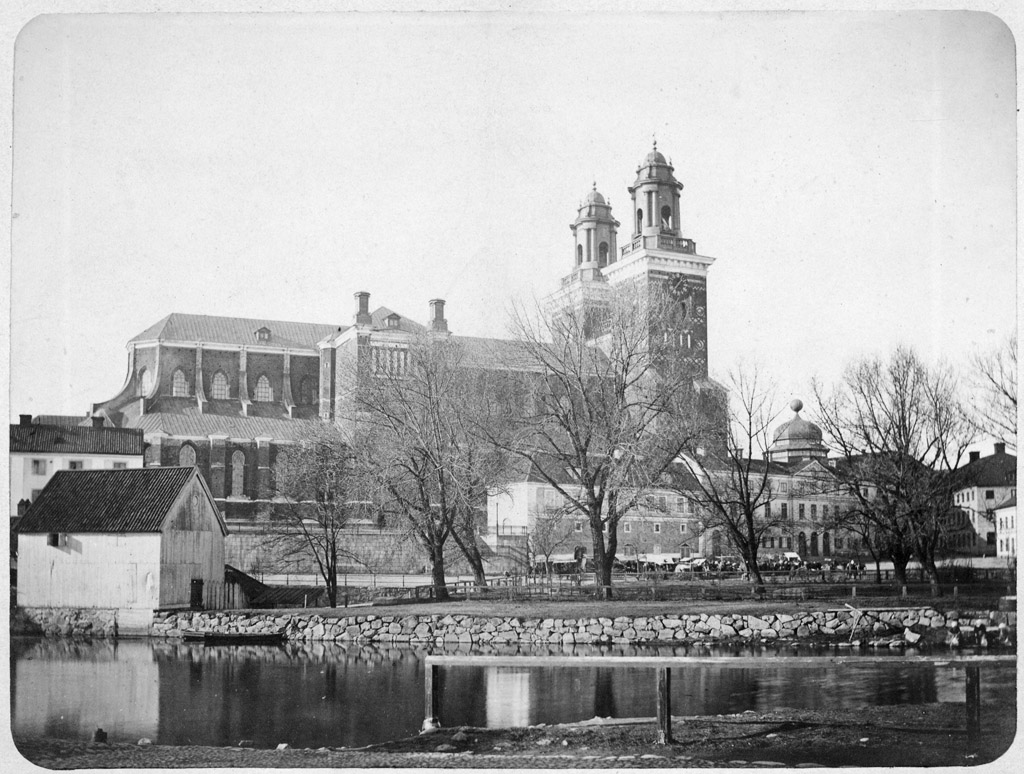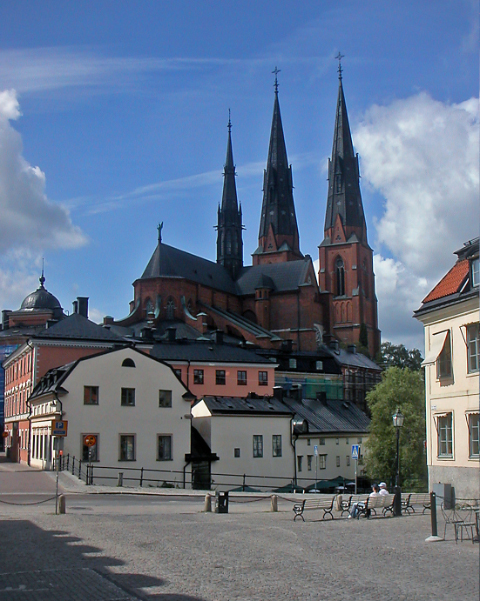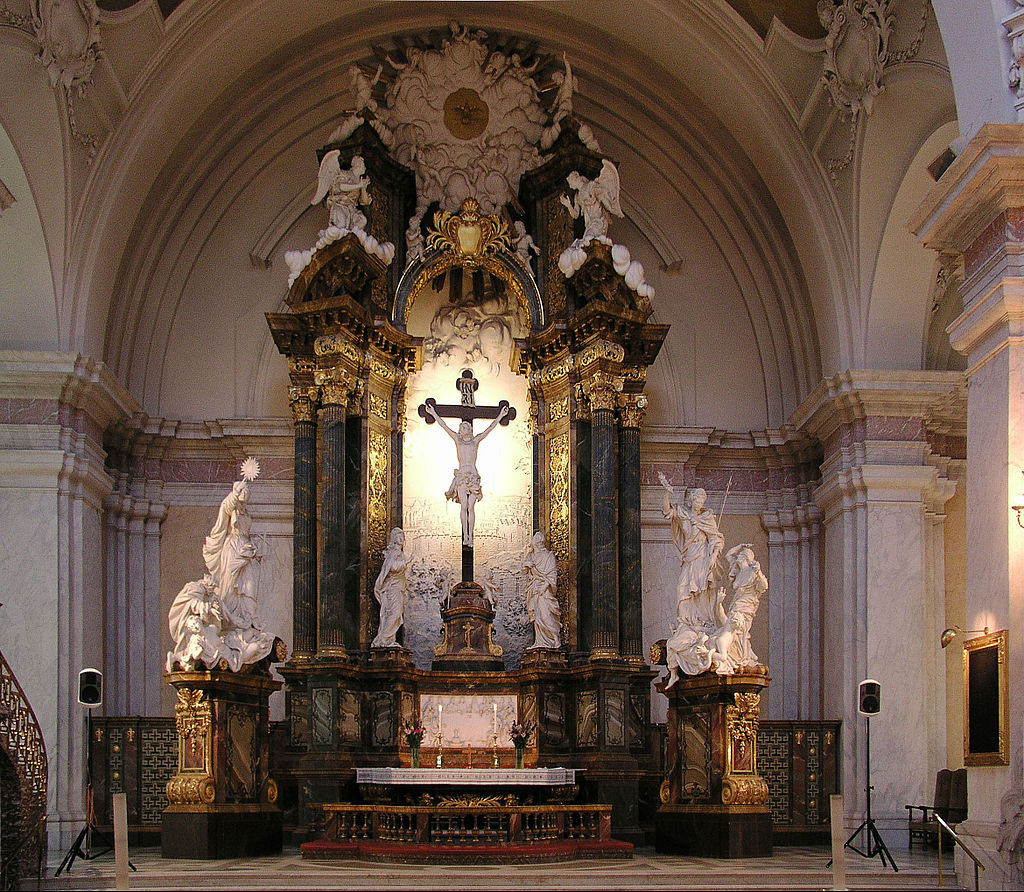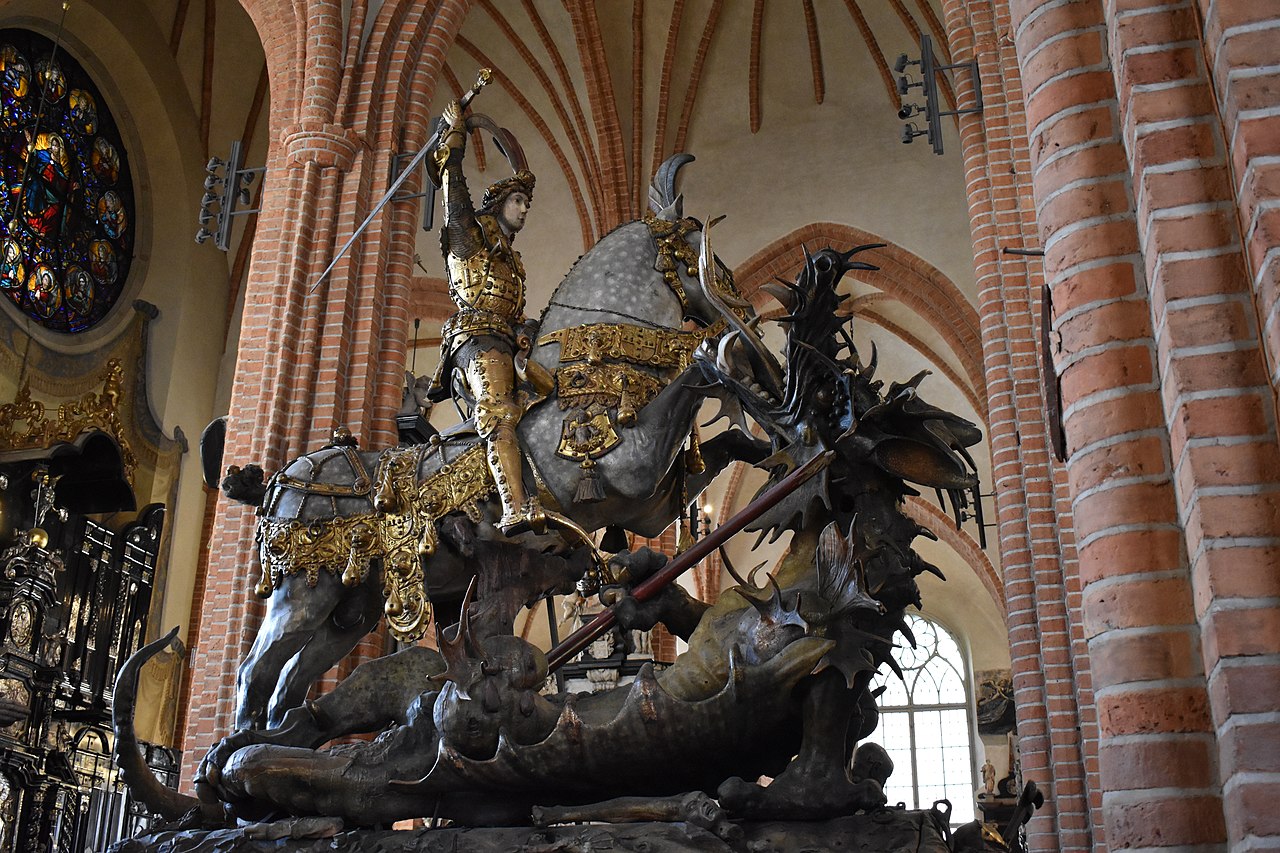by Susan Flantzer
© Unofficial Royalty 2022

The integration of the Augustinerkirche with the Hofburg Palace can be seen in this photo. The church is located below the church tower; Credit – By SchiDD – Own work, CC BY-SA 4.0, https://commons.wikimedia.org/w/index.php?curid=37007074
The Augustinerkirche (Augustinian Church), which this writer has visited, is a Roman Catholic church located in Vienna, Austria, adjacent to the Hofburg Palace, the winter palace of the Habsburgs. Originally built as a separate building, the church became integrated with the Hofburg Palace as the palace expanded over the centuries. The church looks relatively inconspicuous from the outside but it has an impressive interior. The Augustinerkirche is most known for its Herzgruft (Heart Crypt) in the Loreto Chapel where silver urns containing the hearts of Habsburg family members are interred (see below).

Engraving of the image of the original Augustinerkirche (on the left) and the Hofburg Palace (on the right)
In 1327, Friedrich I, Duke of Austria founded a monastery with a church for the Augustinian order of monks. The church was built as a Gothic three-aisled hall church by the Bavarian builder Dietrich Ladtner of Pirna from 1330 – 1339 but it was not consecrated until 1349. In 1634, the Augustinerkirche became the imperial court parish church and remained so until the end of the monarchy in 1918. After the church was named the imperial court parish church, it was renovated in the Baroque style and a tower was added in 1652. During the reign of Holy Roman Emperor Joseph II, eighteen side altars were removed when the church was restored to its original Gothic style by Austrian architect Johann Ferdinand Hetzendorf von Hohenberg (link in German).
*********************
A Note About Two Habsburg Rulers

Empress Maria Theresa; Credit – Wikipedia
Empress Maria Theresa: Born Archduchess Maria Theresa of Austria, she was the second and eldest surviving child of Holy Roman Emperor Karl VI. Her only brother died several weeks before she was born and her two younger siblings were sisters. The fact that Maria Theresa’s father did not have a male heir caused many problems. Maria Theresa’s right to succeed to her father’s Habsburg territories in her own right was the cause of the eight-year-long War of the Austrian Succession. Upon her father’s death in 1740, Maria Theresa became the sovereign in her own right of all the Habsburg territories which included Austria, Hungary, Croatia, Bohemia, Transylvania, Mantua, Milan, Lodomeria and Galicia, the Austrian Netherlands, and Parma. However, she was unable to become the sovereign of the Holy Roman Empire because she was female. The Habsburgs had been elected Holy Roman Emperors since 1438, but in 1742 Karl Albrecht, Duke of Bavaria and Prince-Elector of Bavaria from the Bavarian House of Wittelsbach was elected Holy Roman Emperor Karl VII. He died in 1745 and via a treaty, Maria Theresa arranged for her husband Francis Stephen, Duke of Lorraine to be elected Holy Roman Emperor. Despite the snub, the formidable Maria Theresa wielded the real power and in reality, ruled the Holy Roman Empire. She is generally referred to by historians simply as Empress Maria Theresa and that is how she is referred to in this article.

Emperor Franz I of Austria, formerly Holy Roman Emperor Franz II; Credit – Wikipedia
Holy Roman Emperor Franz II = Emperor Franz I of Austria: Upon the death of his father Holy Roman Emperor Leopold II in 1792, Franz was elected the last Holy Roman Emperor and reigned as Holy Roman Emperor Franz I. Franz feared that Napoleon Bonaparte could take over his personal Habsburg territories within the Holy Roman Empire, so in 1804 he proclaimed himself Emperor Franz I of Austria and reigned until he died in 1835. Franz’s decision proved to be a wise one. Two years later, after Napoleon’s victory at the Battle of Austerlitz, the Holy Roman Empire was dissolved and lands that had been held by the Holy Roman Emperor were given to Napoleon’s allies creating the Kingdom of Bavaria, the Kingdom of Württemberg, and the Grand Duchy of Baden. Franz is referred to as Emperor Franz I of Austria in this article.
*********************
The High Altar

The high altar; Credit – Autor: Bwag – Vlastní dílo, CC BY-SA 3.0 at, https://commons.wikimedia.org/w/index.php?curid=23347194
The current high altar was designed and made by German sculptor Andreas Halbig from 1857 – 1870. It was made from sandstone and made in the polychrome style, the decoration of architectural elements and sculpture in a variety of colors. The altar was originally made for the Votivkirche in Vienna but the architect of the Votivkirche rejected the altar because it would have prevented a view of the ambulatory, so the altar was installed in the Augustinerkirche in 1873. The altar shows Christ the King as ruler of the world, surrounded by angels and saints.
*********************
The Altar Dedicated to Blessed Karl of Austria, the last Emperor of Austria

The altar dedicated to Blessed Karl of Austria in the Augustinerkirche; Photo Credit – © Susan Flantzer
In 2004, a new side altar was dedicated to Blessed Karl of Austria. On October 3, 2004, Pope John Paul II beatified Karl I, the last Emperor of Austria, and he is known as Blessed Karl of Austria. Beatification is the third of four steps toward sainthood in the Roman Catholic Church. On January 31, 2008, the Roman Catholic Church, after a 16-month investigation, formally recognized a second miracle attributed to Karl I which is required for his canonization as a saint. However, no word on his canonization has been forthcoming.
*********************
The Cenotaph of Archduchess Maria Christina of Austria, Duchess of Teschen
Archduchess Maria Christina of Austria (1742 – 1798), was the fifth of the sixteen children of Empress Maria Theresa and Francis I Stephen, Holy Roman Emperor. According to Empress Maria Theresa’s writings, Maria Christina was her favorite child. Allowed to marry for love, Maria Christina married Prince Albrecht of Saxony. The couple received the Duchy of Teschen, and Maria Christina and her husband were jointly appointed Governor of the Austrian Netherlands, serving from 1781 – 1789 and 1791 – 1792. Maria Christina’s last illness was a long one. The day before her death at the age of 56, she wrote a farewell letter to her husband in which she told him of her deep and lifelong love for him. After the death of his wife, her grieving husband Albrecht had an impressive cenotaph (empty tomb) built for Maria Christina, designed and sculpted by Italian neoclassical sculptor Antonio Canova.
*********************
Habsburg Weddings

The wedding of Crown Prince Rudolf of Austria and Princess Stéphanie of Belgium; Credit – Wikipedia
Information about the Augustinerkirche often says many Habsburg weddings took place there. In reality, many of these marriages were proxy marriages. A proxy marriage was a wedding in which one or both of the individuals being married are not physically present, usually being represented instead by other persons. It was very common during this time period for princesses to have a proxy marriage in their home country. The groom would usually be represented by one of the bride’s male relatives. Once the bride arrived in the groom’s home country, a larger religious ceremony was usually held.
For example, the proxy marriage of Archduchess Maria Antonia of Austria, daughter of Empress Maria Theresa, and Louis-Auguste, Dauphin of France, the future Queen Marie Antoinette and King Louis XVI of France, was held at the Augustinerkirche in Vienna on April 19, 1770, with Maria Antonia’s brother Archduke Ferdinand of Austria standing in for Louis-Auguste, Dauphin of France. On May 16, 1770, Maria Antonia, now known by her French name Marie Antoinette, and Louis-Auguste were married in person in a grand ceremony held in the Chapel Royal at the Palace of Versailles in Versailles, France.
The weddings below were ceremonies where both the bride and groom were present in the Augustinerkirche. They were not proxy marriages. This is very likely an incomplete list.
- February 12, 1736 – Archduchess Maria Theresa of Austria (Empress Maria Theresa) and Francis Stephen, Duke of Lorraine
- October 6, 1760 – Holy Roman Emperor Joseph II and his first wife Princess Isabella of Parma
- November 10, 1816 – Emperor Franz I of Austria and his fourth wife Princess Caroline Augusta of Bavaria
- April 24, 1854 – Emperor Franz Joseph I of Austria and Duchess Elisabeth in Bavaria
- February 20, 1868 – Archduchess Maria Theresia of Austria-Este and King Ludwig III of Bavaria
- May 10, 1881 – Crown Prince Rudolf of Austria and Princess Stéphanie of Belgium
***********************
What is Separate Burial?
A separate burial is a form of partial burial in which internal organs are buried separately from the rest of the body. Separate burials of the heart, viscera (the intestines), and the body were common in the House of Habsburg starting with the death of Ferdinand IV, King of the Romans in 1654 until the death of Archduke Franz Karl in 1878. Ferdinand IV of the Romans (1633 – 1654), son of Holy Emperor Ferdinand III, had a strong devotion to the Blessed Virgin Mary and requested that his heart be interred in the Loreto Chapel at the Augustinekirche in Vienna. This established the tradition of interring the hearts of members of the Habsburg family in a crypt alongside the heart of Ferdinand IV. Until then, the hearts of Habsburgs had mostly been buried with the body in the coffin at the Imperial Crypt in the nearby Capuchin Church in Vienna or in St. Stephen’s Cathedral in Vienna where the entrails of the Habsburgs were traditionally interred. With the death of Ferdinand IV, King of the Romans, it became traditional for the body to be interred in the Imperial Crypt in the Capuchin Church in Vienna, the heart to be placed in an urn in the Herzgruft, the Heart Crypt in the Loreto Chapel of the Augustinerkirche in Vienna, and the entrails to be placed in an urn in the Ducal Crypt of St. Stephen’s Cathedral in Vienna.
After the end of the monarchy in 1918, some members of the Habsburg family resumed the tradition of heart burial but not viscera burial. When Karl I, the last Emperor of Austria, died in 1922, he was not allowed to be buried in the Imperial Crypt in Vienna, and instead was buried at the Church of Our Lady of Monte on the island of Madeira in Portugal. His heart remained with his widow Empress Zita until it was interred in the Loreto Chapel of the Muri Monastery in Switzerland in 1971. When Empress Zita died in 1989, her body was buried in the Imperial Crypt at the Capuchin Church in Vienna and her heart was interred with her husband’s heart in the Loreto Chapel of the Muri Monastery in Switzerland. Karl and Zita’s son Otto von Habsburg, the last Crown Prince of Austria, requested that his heart be buried in the crypt of the Benedictine Abbey of Pannonhalma in Hungary. His body was interred in the Imperial Crypt at the Capuchin Church. The body of Otto’s wife Regina of Saxe-Meiningen was also interred in the Imperial Crypt but she requested that her heart be interred in her family’s crypt at Veste Heldburg (link in German) in Heldburg, Germany.
***********************
Herzgruft – Heart Crypt in the Loreto Chapel

Loreto Chapel, the metal door to the left of the altar leads to the Herzgruft (Heart Crypt; Credit – Wikipedia
The Herzgruft (Heart Crypt) in the Loreto Chapel has 54 silver urns containing the hearts of 54 members of the Habsburg family. The chapel is dedicated to the Blessed Virgin Mary as Our Lady of Loreto. The women from the House of Habsburg prayed for the gift of children in the Loreto Chapel, and after giving birth, they offered prayers of thanksgiving in the chapel.
During the renovations of the Augustinerkirche by Austrian architect Johann Ferdinand Hetzendorf von Hohenberg (link in German), the original Loreto Chapel was demolished and a new one was built. A separate room in the new Loreto Chapel was set up for the heart urns. At the same time, the hearts of Anna of Tyrol, Holy Roman Empress, Holy Roman Emperor Matthias, and Holy Roman Emperor Ferdinand II, originally interred in the royal monastery of the Poor Clares next to the Hofburg Palace, were transferred to the Loreto Chapel. The last Habsburg whose heart was interred at the Loreto Chapel was Archduke Franz Karl, son of Emperor Franz I of Austria and father of Emperor Franz Joseph I of Austria, who died in 1878.

Urns with hearts in the Herzgruft (Heart Crypt); Credit – Autor: Gugerell – Vlastní dílo, CC0, https://commons.wikimedia.org/w/index.php?curid=28367548
The current Loreto Chapel, located behind a wrought iron gate in the right aisle, adjacent to the high altar, was built in 1724 and is the successor to the original 1627 Loreto Chapel. Access to the heart crypt is by an iron door to the left of the altar in the Loreto Chapel. The heart crypt is a semicircular room with bare walls in which the urns are placed on two shelves side by side in the sequence of death dates. The heart urns are made of silver except for the gold urn of Holy Roman Emperor Matthias. The heart urn of Prince Napoleon II of France, son of Napoléon Bonaparte, Emperor of the French and his second wife Archduchess Maria Louise of Austria, daughter of Emperor Franz I of Austria, is usually decorated with a ribbon in the blue, white, and red colors of the French tricolor.
All but three of those whose hearts are interred in the Augustinerkirche are buried in the Imperial Crypt in the Capuchin Church in Vienna, a short distance from the Augustinekirche. The burial place of those three is noted below.
- Unofficial Royalty: A Visit to the Kaisergruft (Imperial Crypt) in Vienna
- Unofficial Royalty: Austrian Imperial Burial Sites: House of Habsburg-Lorraine: Emperors of Austria
Note: Holy Roman Emperors were elected. The Habsburg Holy Roman Emperors were also the Kings of Hungary, Croatia, and Bohemia and sovereigns of Austria and other Habsburg territories.
The upper row of heart urns arranged in sequence of death dates, from left to right:
- Anna of Tyrol, Holy Roman Empress (1585 – 1618), wife of her cousin Holy Roman Emperor Matthias
- Holy Roman Emperor Matthias (1557 – 1619)
- Holy Roman Emperor Ferdinand II (1578 – 1637), buried in the Grazer Dom in Graz, Austria
- King Ferdinand IV of the Romans (1633 – 1654), son of Holy Emperor Ferdinand III
- Archduke Leopold Wilhelm of Austria, Bishop of Olomouc, Bishop of Breslau, and Grand Master of the Teutonic Knights (1614 – 1662), son of Holy Roman Emperor Ferdinand II
- Margarita Teresa of Spain, Holy Roman Empress (1651- 1673), niece, cousin, and first wife of Holy Emperor Leopold I
- Eleonora Magdalena of Mantua, Holy Roman Empress (1630 – 1686), third wife of Holy Emperor Ferdinand III
- Archduchess Maria Antonia of Austria, Electress of Bavaria (1669 – 1692), daughter of Holy Emperor Leopold I, wife of Maximilian II Emanuel, Elector of Bavaria
- Archduchess Maria Theresia of Austria (1684 – 1696), daughter of Holy Emperor Leopold I
- Archduchess Maria Josepha of Austria (1687 – 1703), daughter of Holy Emperor Leopold I
- Holy Roman Emperor Leopold I (1640 – 1705)
- Holy Roman Emperor Joseph I (1678 – 1711)
- Holy Roman Emperor Karl VI (1685 – 1740)
- Archduchess Maria Elisabeth of Austria, Governor of the Austrian Netherlands (1680–1741), daughter of Holy Emperor Leopold I
- Archduchess Maria Anna of Austria, Governor of the Austrian Netherlands (1718 – 1744), daughter of Holy Emperor Karl VI
- Unnamed princess (born and died 1744), daughter of Prince Charles of Lorraine and Archduchess Maria Anna of Austria
- Elisabeth Christine of Brunswick-Wolfenbüttel, Holy Roman Empress (1691 – 1750), wife of Holy Emperor Karl VI
- Archduke Karl Joseph of Austria (1745 – 1761), son of Holy Emperor Francis I Stephen and Empress Maria Theresa
- Archduchess Maria Johanna of Austria (1750 – 1762), daughter of Holy Emperor Francis I Stephen and Empress Maria Theresa
- Franz I Stephen, Holy Roman Emperor, Duke of Lorraine, and Grand Duke of Tuscany (1708 – 1765), husband of Empress Maria Theresa
- Empress Maria Theresa, Archduchess of Austria, and Queen of Hungary, Croatia, and Bohemia in her own right (1717 – 1780), eldest surviving child of Emperor Karl VI, wife of Holy Emperor Franz I Stephen
- Archduchess Louise Elisabeth (1790 – 1791), daughter of Emperor Franz II of Austria
- Holy Roman Emperor Leopold II (1747 – 1792)
- Maria Luisa of Spain, Holy Roman Empress (1745 – 1792), wife of Holy Emperor Leopold II
- Archduchess Maria Karoline Leopoldine of Austria (1794 – 1795), daughter of Holy Emperor Franz II
- Archduke Alexander Leopold, Palatine of Hungary (1772 – 1795), son of Holy Emperor Leopold II
- Archduchess Maria Amalia of Austria (1780 – 1798), daughter of Holy Emperor Leopold II
- Archduchess Maria Christina of Austria (1742 – 1798), daughter of Empress Maria Theresa, wife of Prince Albrecht of Saxony, Duke of Teschen
- Archduchess Caroline Ludovika of Austria (1795 – 1799), daughter of Emperor Franz I of Austria
- Archduke Maximilian Franz of Austria, Archbishop of Cologne (1756 – 1801), son of Empress Maria Theresa
- Archduchess Karoline Ferdinanda of Austria (1793 – 1802), granddaughter of Holy Roman Emperor Leopold II
- Luisa of Naples and Sicily, Grand Duchess of Tuscany (1773 – 1802), granddaughter of Empress Maria Theresa, first wife of Ferdinando III, Grand Duke of Tuscany
The lower row of heart urns arranged in sequence of death dates, from left to right:
- Archduchess Marie Amalie of Austria, Duchess of Parma (1746 – 1804), daughter of Empress Maria Theresa, wife of Ferdinand I, Duke of Parma, buried in St. Vitus Cathedral in Prague, Kingdom of Bohemia, now in the Czech Republic
- Archduke Ferdinand of Austria (1754 – 1806), son of Empress Maria Theresa
- Maria Theresa of Naples and Sicily, Empress of Austria (1772 – 1807), second wife of Emperor Franz I of Austria
- Archduke Joseph of Austria (1799 – 1807), son of Emperor Franz I of Austria
- Archduke Johann Nepomuk of Austria (1805 – 1809), son of Emperor Franz I of Austria
- Maria Carolina of Austria, Queen of Naples and Sicily (1752 – 1814), daughter of Empress Maria Theresa, wife of King Ferdinand IV of Naples and Sicily
- Maria Ludovika of Austria-Este, Empress of Austria (1787 – 1816), third wife of Emperor Franz I of Austria
- Prince Albrecht of Saxony, Duke of Teschen (1738 – 1822), husband of Archduchess Maria Christina of Austria
- Archduke Rudolph Franz of Austria (born and died 1822), son of Archduke Karl of Austria, Duke of Teschen and grandson of Emperor Leopold II
- Prince Napoleon II of France (1811 – 1832), son of Napoléon Bonaparte, Emperor of the French and his second wife Archduchess Maria Louise of Austria, daughter of Franz I, Emperor of Austria; buried in Les Invalides in Paris, France
- Emperor Franz I of Austria (formerly Franz II, Holy Roman Emperor) (1768 – 1835)
- Archduke Anton Viktor of Austria (1779 – 1835), son of Holy Emperor Leopold II
- Archduke Karl of Austria, Duke of Teschen (1771 – 1847), son of Emperor Leopold II
- Archduke Ferdinand Karl Joseph of Austria-Este (1781 – 1850), son of Archduke Ferdinand of Austria-Este and grandson of Emperor Franz I of Austria
- Archduke Franz Joseph of Austria-Teschen (born and died 1855), son of Archduke Karl of Austria, Duke of Teschen and grandson of Holy Roman Emperor Leopold II
- Archduchess Maria Anna of Austria (1804 – 1858), daughter of Emperor Franz I of Austria
- Hildegard of Bavaria, Archduchess of Austria (1825 – 1864), wife of Archduke Albrecht of Austria, son of Archduke Karl of Austria, Duke of Teschen
- Archduke Ludwig Joseph of Austria (1784 – 1864), son of Holy Roman Emperor Leopold II
- Maria Ferdinanda of Saxony, Grand Duchess of Tuscany (1796 – 1865), second wife of Ferdinand III, Grand Duke of Tuscany
- Archduchess Mathilde of Austria-Teschen (1849 – 1867), daughter of Archduke Albrecht of Austria, Duke of Teschen
- Emperor Ferdinand I of Austria (1793 – 1875)
- Archduke Franz Karl of Austria (1802 – 1878), son of Emperor Franz I of Austria and father of Emperor Franz Joseph I of Austria
This article is the intellectual property of Unofficial Royalty and is NOT TO BE COPIED, EDITED, OR POSTED IN ANY FORM ON ANOTHER WEBSITE under any circumstances. It is permissible to use a link that directs to Unofficial Royalty.
Works Cited
- Augustinerkirche Wien. 2021. Augustinerkirche Wien. [online] Available at: <https://augustinerkirche.augustiner.at/> [Accessed 11 December 2021].
- Cs.wikipedia.org. 2021. Augustiniánský kostel (Vídeň) – Wikipedie. [online] Available at: <https://cs.wikipedia.org/wiki/Augustini%C3%A1nsk%C3%BD_kostel_(V%C3%ADde%C5%88)> [Accessed 11 December 2021].
- Cs.wikipedia.org. 2021. Hrobka srdcí – Wikipedie. [online] Available at: <https://cs.wikipedia.org/wiki/Hrobka_srdc%C3%AD> [Accessed 11 December 2021].
- De.wikipedia.org. 2021. Augustinerkirche (Wien) – Wikipedia. [online] Available at: <https://de.wikipedia.org/wiki/Augustinerkirche_(Wien)> [Accessed 11 December 2021].
- De.wikipedia.org. 2021. Loretokapelle (Augustinerkirche Wien) – Wikipedia. [online] Available at: <https://de.wikipedia.org/wiki/Loretokapelle_(Augustinerkirche_Wien)> [Accessed 11 December 2021].
- En.wikipedia.org. 2021. Augustinian Church, Vienna – Wikipedia. [online] Available at: <https://en.wikipedia.org/wiki/Augustinian_Church,_Vienna> [Accessed 11 December 2021].
- En.wikipedia.org. 2021. Herzgruft – Wikipedia. [online] Available at: <https://en.wikipedia.org/wiki/Herzgruft_(Vienna)> [Accessed 11 December 2021].




































